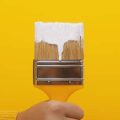1. Preparing Your Space for Painting
Before you open a single can of paint, its crucial to prepare your space properly. Good prep work not only makes painting easier but also ensures a smooth, professional-looking finish that lasts. Here’s how to get your interior ready for a fresh coat of paint.
Clean the Walls
Dirt, dust, and grease can prevent paint from adhering properly. Use a mild detergent mixed with warm water and a sponge to wash the walls, especially in kitchens and bathrooms where buildup is common. Let the walls dry completely before moving on.
Repair Any Wall Damage
Inspect the walls for any holes, dents, or cracks. Use spackling paste or joint compound to fill small imperfections. For larger holes, patch kits are available at most hardware stores. After repairs dry, sand them smooth with fine-grit sandpaper.
Tape Off Edges and Fixtures
Painter’s tape is your best friend when it comes to getting clean edges. Apply tape around trim, windows, door frames, light switches, and outlets. Make sure the tape is firmly pressed down to prevent paint bleed-through.
Protect Furniture and Flooring
Move as much furniture out of the room as possible. For larger items that cant be moved, group them in the center and cover them with plastic sheeting or drop cloths. Protect your floors with canvas or plastic drop cloths secured with painters tape.
Recommended Supplies Checklist
| Item | Purpose |
|---|---|
| Mild Detergent & Sponge | Cleans dirt and grime from walls |
| Spackling Paste/Joint Compound | Fills holes and cracks |
| Fine-Grit Sandpaper | Smooths repaired areas |
| Painters Tape | Protects edges for clean lines |
| Plastic Sheeting/Drop Cloths | Covers furniture and flooring |
Quick Tip:
If youre painting in a high-traffic area like a hallway or kitchen, take extra time cleaning and repairing surfaces—these areas show wear more quickly, so prep work is even more important.
2. Choosing the Right Paint and Finish
Picking the right paint and finish is one of the most important steps in your interior painting project. With so many types of paints and finishes available, it can feel overwhelming. But don’t worry — we’ll break it down in a simple way so you can choose what works best for each room in your home.
Understanding Different Types of Interior Paints
There are two main types of interior paints commonly used in American homes:
1. Latex (Water-Based) Paint
- Most popular choice for interior walls
- Dries quickly and cleans up with soap and water
- Low odor and better for the environment
- Great for living rooms, bedrooms, and hallways
2. Oil-Based Paint
- Durable and smooth finish
- Takes longer to dry and requires mineral spirits for cleanup
- Good for trim, molding, doors, and high-traffic areas
Choosing the Right Sheen (Finish)
The sheen of your paint affects how shiny it looks and how well it holds up to cleaning. Here’s a quick guide to help you decide:
| Sheen Type | Appearance | Best For |
|---|---|---|
| Flat / Matte | No shine; hides imperfections well | Ceilings, low-traffic areas like adult bedrooms |
| Eggshell | Slight sheen; soft look with more durability than flat | Living rooms, dining rooms, family rooms |
| Satin | Smooth, velvety look with a bit more shine | Kitchens, bathrooms, kids’ rooms, hallways |
| Semi-Gloss | Noticeable shine; moisture-resistant and easy to clean | Trim, doors, cabinets, bathrooms, kitchens |
| Gloss / High Gloss | Very shiny; highly durable but shows surface flaws easily | Accent pieces, furniture, doors, trim for a bold look |
Selecting the Right Color for Each Room
Consider Lighting and Mood:
- Natural light: Brighter colors work well in well-lit rooms.
- Darker spaces: Use warm or light tones to open up the space.
- Mood setting: Soft blues and greens are calming (great for bedrooms), while yellows and oranges are energizing (good for kitchens or playrooms).
Tips for Picking Colors:
- Create flow: Stick to a cohesive color palette across rooms.
- Test samples: Try paint swatches on your wall at different times of day to see how lighting affects the color.
- Avoid trends that won’t last: Go with colors that match your style and are timeless rather than super trendy.
- Use neutrals as a base: They allow flexibility with décor changes over time.
Picking Paint by Room Type
| Room Type | Recommended Sheen & Paint Type |
|---|---|
| Living Room | Eggshell or Satin – Latex paint preferred for easy application and clean-up. |
| Kitchen & Bathroom | Satin or Semi-Gloss – Moisture-resistant latex paint helps prevent mildew. |
| Boys’ or Girls’ Bedrooms & Playrooms | Satin – Durable enough to handle messes but still soft-looking. |
| Hallways & Entryways | Satin – Easy to clean scuffs from high-traffic areas. |
| Ceilings & Low-Traffic Rooms (e.g., Guest Bedrooms) | Flat – Hides imperfections well. |
| Moldings, Doors & Trim Work | Semi-Gloss or High Gloss – Adds contrast and durability where needed most. |
Selecting the right type of paint and finish not only enhances the look of your home but also ensures long-lasting results that hold up over time. Take into account the specific function of each room when making your decisions so you can enjoy both beauty and practicality in every space.

3. Essential Tools and Materials
Before you dip your brush into a can of paint, it’s important to gather all the right tools and materials. Having the proper equipment not only makes your job easier but also helps you achieve a cleaner, more professional-looking result. Below is a breakdown of must-have tools for interior painting, along with some optional gadgets that can make the process smoother.
Must-Have Painting Tools
| Tool | Description | Why You Need It |
|---|---|---|
| Paintbrushes | Various sizes; angled brushes are great for corners and trim. | Essential for cutting in edges and detailed work. |
| Paint Rollers | Standard rollers for walls, smaller foam rollers for cabinets or doors. | Covers large areas quickly and evenly. |
| Painters Tape | Low-tack tape designed specifically for painting projects. | Helps create clean lines and protects trim or adjacent surfaces. |
| Drop Cloths | Canvas or plastic sheets to cover floors and furniture. | Prevents paint spills and splatters from damaging surfaces. |
| Paint Tray & Liners | A tray holds the paint while youre rolling, liners make cleanup easy. | Makes it convenient to load rollers with just the right amount of paint. |
| Ladder or Step Stool | For reaching high walls or ceilings safely. | Ensures access to hard-to-reach areas without straining. |
| Sanding Sponge or Sandpaper | Used to smooth out surfaces before painting. | Helps paint adhere better and results in a smoother finish. |
| Putty Knife & Spackle | Fills small holes or cracks in walls before painting. | Prepares walls so the final coat looks flawless. |
Optional But Helpful Gadgets
- Paint Edger: Great for getting clean lines along baseboards or ceilings without using painter’s tape.
- Extension Pole: Attaches to your roller for painting tall walls or ceilings without a ladder.
- Paint Pour Spout: Clips onto a paint can to minimize drips while pouring into trays.
- Painters’ Tool (5-in-1): A multi-use tool that scrapes old paint, opens cans, cleans rollers, and more.
- Tack Cloth: Picks up fine dust after sanding to ensure a clean surface before painting.
Pro Tip:
If youre new to painting, consider purchasing a beginner’s kit. Many home improvement stores offer starter sets that include brushes, rollers, trays, and even painter’s tape—everything you need to get going without making multiple trips to the store.
The right tools don’t just make painting easier—they also help you get better results with less mess and frustration. Investing in quality materials can save you time and effort in the long run.
4. Step-by-Step Painting Techniques
Getting a smooth, professional-looking paint job inside your home doesnt require years of experience—it just takes the right techniques and a little patience. Below is a step-by-step guide to help you cut in clean lines, roll walls evenly, apply coats properly, and avoid common painting mistakes like streaks and drips.
Step 1: Cutting In
Cutting in means painting the edges of the wall where rollers can’t reach—like where the wall meets the ceiling, trim, or corners. Use a high-quality angled brush (usually 2″–2.5″) for better control.
Tips for Cutting In:
- Use painter’s tape if youre not confident with freehand lines.
- Dip only 1/3 of the brush into the paint to prevent dripping.
- Wipe off excess paint on the side of the can before applying.
- Start about an inch away from the edge, then work toward it for a smoother line.
Step 2: Rolling the Walls
Once youve finished cutting in, use a roller to fill in the rest of the wall. A quality roller cover will make a big difference in how even and smooth your finish looks.
Rolling Technique:
- Pour paint into a tray and load your roller by rolling it back and forth until its fully covered but not dripping.
- Start in a corner and roll in a “W” or “M” shape about a 3×3 area.
- Without lifting the roller, fill in the gaps until the section is fully covered.
- Work quickly while paint is still wet to avoid lap marks.
Step 3: Applying Even Coats
A common mistake is applying too much paint at once or not spreading it evenly. Most walls need two coats for full coverage—especially when changing colors.
Even Coat Application Tips:
| Do | Dont |
|---|---|
| Apply thin, consistent coats | Avoid overloading your brush or roller |
| Let each coat dry fully before adding another | Don’t rush between coats—it can cause peeling or uneven texture |
| Use the same type of tool (brush or roller) throughout one coat | Mix tools mid-coat—it can create texture differences |
Step 4: Avoiding Common Mistakes
Mistakes like streaks, drips, and lap marks are easy to make but also easy to avoid with proper technique and preparation.
Common Mistake Prevention:
- Streaks: Usually caused by low-quality brushes or uneven pressure. Use quality tools and apply steady pressure.
- Drips: Happen when theres too much paint on your brush or roller. Always remove excess before applying.
- Lap Marks: Occur when overlapping areas dry before being blended. Work in small sections and keep a wet edge at all times.
The key to successful interior painting is taking your time, using the right tools, and following each step carefully. With practice, you’ll get cleaner lines, smoother walls, and results that look professionally done—even if you did it yourself!
5. Cleanup and Finishing Touches
Once the painting is done, it’s time to wrap up the project properly. A clean finish and well-maintained tools not only make your space look more professional, but also make future projects easier. Here are some simple steps to help you clean up like a pro.
Cleaning Your Painting Tools
Keeping your brushes, rollers, and trays in good shape can save you money and ensure better results next time. Use the table below for quick guidance:
| Tool | Cleaning Method |
|---|---|
| Latex Paint Brushes/Rollers | Wash with warm water and mild soap until water runs clear |
| Oil-Based Paint Brushes | Use paint thinner or mineral spirits, then wash with soap and water |
| Paint Trays | If lined, remove liner and discard; otherwise, scrub with warm soapy water or appropriate solvent |
Removing Painters Tape
Painters often leave tape on too long, which can damage the finish. For best results:
- Remove tape while the paint is still slightly damp or just dry to the touch.
- Pull it off slowly at a 45-degree angle to avoid peeling paint.
- If the tape sticks, score along the edge gently with a utility knife before removing.
Disposing of Leftover Paint Safely
You should never pour leftover paint down the drain. Heres what you can do instead:
- Store extra paint: Seal tightly and label with room name and date for future touch-ups.
- Donate usable leftovers: Many local schools or community centers accept them.
- Dried-up latex paint: Once solidified (using kitty litter or paint hardener), it can usually go in regular trash—check your local regulations.
- Oil-based paints: Must be taken to hazardous waste disposal facilities.
The Final Quality Check
This step ensures your hard work pays off with a polished look:
- Inspect walls in natural light: Look for missed spots, uneven coverage, or drips.
- Smooth out blemishes: Lightly sand rough patches and touch up if needed.
- Crisp edges check: Verify that trim lines are neat—use a small brush for precision fixes if necessary.
A Few Extra Touches
- Add outlet covers, switch plates, and hardware back into place once fully dry.
- Tidy up the room—vacuum any dust or debris from sanding or taping.
- Celebrate your fresh new space!


